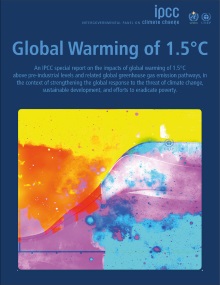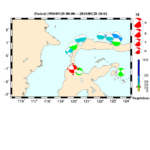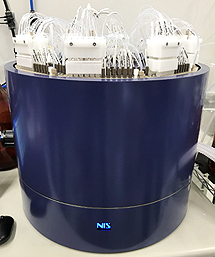2018/10/07 環境省
気候変動に関する政府間パネル(IPCC)第48回総会が、10月1日(月)から6日(土)にかけて、仁川(韓国)において開催されました。今次総会では、IPCC1.5℃特別報告書の政策決定者向け要約(SPM)が承認されるとともに、報告書本編が受諾されました。
*正式タイトル:気候変動の脅威への世界的な対応の強化、持続可能な発展及び貧困撲滅の文脈において工業化以前 の水準から1.5°Cの気温上昇にかかる影響や関連する地球全体での温室効果ガス(GHG)排出経路に関する特別報告書
1.概要
気候変動に関する政府間パネル(IPCC)第48回総会が、10月1日(月)から6日(土)にかけて、仁川(韓国)において開催されました。今次総会では、1.5℃特別報告書に関する議論等が行われ、政策決定者向け要約(SPM)が承認されるとともに、報告書本編が受諾されました。
◆日時
平成30年10月1日(月)から6日(土)までの6日間
◆開催地
仁川(韓国)
◆出席者
各国政府の代表、世界気象機関(WMO)、国連環境計画(UNEP)、気候変動枠組条約(UNFCCC)等の国際機関等の関係者が出席しました。我が国からは、文部科学省、農林水産省、経済産業省、気象庁、環境省などから計21名出席しました。
2.1.5℃特別報告書の背景と概要について
2015年に開催された第21回国連気候変動枠組条約(UNFCCC)締約国会議(COP21)において、UNFCCCは、気候変動に関する政府間パネル(IPCC)に対し工業化以前の水準から1.5°Cの気温上昇にかかる影響や関連する地球全体での温室効果ガス(GHG)排出経路に関する特別報告書を2018年に提供することを招請しました。
本報告書は、これをうけIPCCが、2016年4月に開催された第43回総会において作成を決定したものです(同年10月の第44回総会でそのアウトライン及びスケジュールを決定)。タイトルにあるように、気候変動の脅威への世界的な対応の強化と、持続可能な発展及び貧困撲滅の文脈のなかで、1.5°Cの気温上昇にかかる影響、リスク及びそれに対する適応、関連する排出経路、温室効果ガスの削減(緩和)等に関する特別報告書となっています。
1.5℃特別報告書のSPMの構成、報告書本編のアウトライン、及び作成スケジュールは以下の通りです。また、SPM各セクションの概要は別紙(添付資料)を参照してください。
【SPM】
はじめに
セクションA: 1.5℃の地球温暖化の理解
セクションB:予測される気候変動、潜在的な影響及び関連するリスク
セクションC: 1.5℃の地球温暖化に整合する排出経路とシステムの移行
セクションD: 持続可能な開発及び貧困撲滅への努力の文脈における世界的な対応の強化
ボックスSPM1:SR1.5において重要な定義
【報告書本編】
第1章:枠組みと文脈
第2章:持続可能な開発の文脈において1.5℃と整合する緩和経路
第3章:自然及び人間システムにおける1.5℃地球温暖化の影響
第4章:気候変動の脅威に対する世界的な対応の強化と実施
第5章:持続可能な開発、貧困の撲滅及び不平等の削減
【作成スケジュール】
2016年10月~11月 執筆者の推薦募集
2017年1月末 執筆者の選出
2017年3月 第1回代表執筆者会合
2017年6月 第2回代表執筆者会合
2017年8月~9月 第1次ドラフト専門家レビュー
2017年10月 第3回代表執筆者会合
2018年1月〜2月 第2次ドラフト専門家・政府レビュー
2018年4月 第4回代表執筆者会合
2018年6月〜7月 政策決定者向け要約(SPM)の最終政府レビュー
2018年10月 IPCCによる承認・受諾
3.次回総会の予定
第49回総会は2019年5月8日(水)から12日(日)に、京都(日本)において開催される予定です(2006年IPCC国別温室効果ガスインベントリガイドラインの2019年改良(Refinement)報告書の採択が議論)。
参考
IPCCとは
◆国連環境計画(UNEP)及び世界気象機関(WMO)により1988年に設立された政府間機関。
◆報告書の作成には、世界各国の研究者数千名が参加。
◆地球温暖化に関する科学的・技術的・社会経済的な見地から包括的な評価を政策決定者等に提供。
◆総会においては、成果物である報告書の承認、今後の活動方針の検討等が行われる。
◆総会の下、第1作業部会(自然科学的根拠)、第2作業部会(影響・適応・脆弱性)、第3作業部会(緩和策)、インベントリ・タスクフォース(排出量算定方法の開発・改善を担う)が置かれている。
IPCC評価報告書
◆これまで5回(第5次評価報告書(AR5)は2013-2014年公開)にわたり評価報告書を作成・公表。
◆国際交渉、各国の政策決定の基礎となる科学的知見を提供してきた。
◆現在第6次評価報告書(AR6)公表に向けた作業が進行中。
- 連絡先
- 環境省地球環境局総務課研究調査室
室長 大井 通博 (内線6732)
室長補佐 長谷 代子 (内線7761)
担当 加藤 尚 (内線7761)
添付資料
(別紙)1.5℃特別報告書 政策決定者向け要約(SPM)の概要 [PDF 438 KB]

1.5℃の地球温暖化:気候変動の脅威への世界的な対応の強化、持続可能な開発及び貧困撲 滅への努力の文脈における、工業化以前の水準から 1.5℃の地球温暖化による影響及び関 連する地球全体での温室効果ガス(GHG)排出経路に関する IPCC 特別報告書政策決定者向け要約(SPM)の概要
(2018年10月6日承認済みSPM IPCC-XLVIII/Doc. 5に基づく仮訳)
(図表注釈、引用元章番号等は省略している)
A. Understanding Global Warming of 1.5°C A. 1.5℃の地球温暖化の理解
(注釈5) Present level of global warming is defined as the average of a 30-year period centered on 2017 assuming the recent rate of warming continues.A1. 人為活動は、工業化以前の水準よりも約 1℃(可能性の幅は 0.8℃から 1.2℃)温暖化 (注釈5)させた と推定される。地球温暖化は、現在の度合いで続けば、2030 年から 2052 年の間に 1.5℃に達する可能性 が高い。(確信度が高い)
注釈5:現在の地球温暖化の水準は、近年みられる度合いで地球温暖化が進むと仮定
して、2017 年を中心とする 30 年平均値とした。
A2. Warming from anthropogenic emissions from the pre-industrial period to the present will persist for centuries to millennia and will continue to cause further long-term changes in the climate system, such as sea level rise, with associated impacts (high confidence), but these emissions alone are unlikely to cause global warming of 1.5°C (medium confidence).
A2. 工業化以前から現在までの人為的な排出による地球温暖化は、数百年から数千年にわたって継続し、 関連する影響を伴いながら、気候システムにおけるさらなる長期的変化(例えば海面水位の上昇など) を継続的に引き起こす(確信度が高い)。しかしながらこれらの排出量のみで、1.5℃の地球温暖化をも たらす可能性は低い(確信度が中程度)。
A3. Climate-related risks for natural and human systems are higher for global warming of 1.5°C than at present, but lower than at 2°C (high confidence). These risks depend on the magnitude and rate of warming, geographic location, levels of development and vulnerability, and on the choices and implementation of adaptation and mitigation options (high confidence).
A3. 1.5℃の地球温暖化における、自然及び人間システムに対する気候に関連するリスクは、現在よりも 高く、2℃よりも低い(確信度が高い)。これらのリスクは、温暖化の度合い、地理的な位置、開発及び 脆弱性の水準、並びに適応及び緩和の選択肢の選定に依存する(確信度が高い)。
B. Projected Climate Change, Potential Impacts and Associated Risks B. 予測される気候変動、潜在的な影響及び関連するリスク
(注釈7) Robust is here used to mean that at least two thirds of climate models show the same sign of changes at the grid point scale, and that differences in large regions are statistically significant.
(注釈8)Projected changes in impacts between different levels of global warming are determined with respect to changes in global surface air temperature.B1. 気候モデルは、現在と 1.5℃(注釈8)の地球温暖化の間、及び 1.5℃と 2℃(の地球温暖化)との間で は、地域ごとに気候特性にロバスト(注釈7)な違いがあると予測する。これらの違いには、ほとんどの陸 域及び海域における平均気温上昇(確信度が高い)、人間が居住するほとんどの地域における極端な高 温(確信度が高い)、いくつかの地域における強い降水現象(確信度が中程度)、及びいくつかの地域に おける干ばつと降水不足の確率の増加(確信度が中程度)が含まれる。
注釈7:ロバストとは、ここでは少なくとも気候モデルの 3 分の 2 が格子点スケール で同じ変 化の兆候を示し、広範な地域での違いが統計的に有意であることを意味するために用いられる。
注釈8:地球温暖化の異なるレベル間での予測された影響の変化は、世界平均地上気温の変化 に基づいて決定される。
B2. By 2100, global mean sea level rise is projected to be around 0.1 metre lower with global warming of 1.5°C compared to 2°C (medium confidence). Sea level will continue to rise well beyond 2100 (high confidence), and the magnitude and rate of this rise depends on future emission pathways. A slower rate of sea level rise enables greater opportunities for adaptation in the human and ecological systems of small islands, low-lying coastal areas and deltas (medium confidence).
B2. 1.5℃の地球温暖化の場合、2100 年までの海面水位の上昇は、2℃の地球温暖化よりも 0.1m 低いと 予測される(確信度が中程度)。海面水位の上昇は 2100 年のはるか先も継続し(確信度が高い)、この 上昇の大きさと速度は将来の排出経路に依存する。海面水位の上昇がより緩やかになれば、小島嶼、 沿岸低平地及びデルタ地帯の人間と生態系システムの適応機会が増加する(確信度が中程度)。
B3. On land, impacts on biodiversity and ecosystems, including species loss and extinction, are projected to be lower at 1.5°C of global warming compared to 2°C. Limiting global warming to 1.5°C compared to 2°C is projected to lower the impacts on terrestrial, freshwater, and coastal ecosystems and to retain more of their services to humans (high confidence).
B3. 陸域では、種の喪失及び絶滅を含む、生物多様性及び生態系に対する影響は、2℃よりも 1.5℃の 地球温暖化の方が低いと予測される。地球温暖化を 2℃よりも 1.5℃に抑えることは、陸域、淡水、及 び沿岸域の生態系が受ける影響を低減し、並びにそれらが提供する人間へのサービスをより多く保持 させると予測される(確信度が高い)。
B4. Limiting global warming to 1.5°C compared to 2ºC is projected to reduce increases in ocean temperature as well as associated increases in ocean acidity and decreases in ocean oxygen levels (high confidence). Consequently, limiting global warming to 1.5°C is projected to reduce risks to marine biodiversity, fisheries, and ecosystems, and their functions and services to humans, as illustrated by recent changes to Arctic sea ice and warm water coral reef ecosystems (high confidence).
B4. 2℃よりも 1.5℃の地球温暖化に抑えることによって、海水温の上昇、並びにそれに関連する海洋 酸性度の上昇及び海洋酸素濃度水準の低下を低減させると予測される(確信度が高い)。それに伴い、 1.5℃に地球温暖化を抑えることによって、海洋生物多様性、漁業資源、及び生態系、並びにこれらがも たらす人間への機能とサービスに対するリスクが減少することが予測される。これは北極の海氷及び暖 水性サンゴの生態系における近年の変化によっても明らかである(確信度が高い)。
B5. Climate-related risks to health, livelihoods, food security, water supply, human security, and economic growth are projected to increase with global warming of 1.5°C and increase further with 2°C.
B5 健康、生計、食料安全保障、水供給、人間の安全保障、及び経済成長に対する気候関連のリスクは、 1.5℃の地球温暖化において増加し、2℃においてはさらに増加すると予測されている。
B6. Most adaptation needs will be lower for global warming of 1.5°C compared to 2°C (high confidence). There are a wide range of adaptation options that can reduce the risks of climate change (high confidence). There are limits to adaptation and adaptive capacity for some human and natural systems at global warming of 1.5°C, with associated losses (medium confidence). The number and availability of adaptation options vary by sector (medium confidence).
B6. ほとんどの適応ニーズは、2℃よりも、1.5℃の地球温暖化において少なくなる(確信度が高い)。気 候変動のリスクを減らすことが可能な適応のオプションは幅広く存在している(確信度が高い)。いく つかの人間及び自然システムにとっては、1.5℃の地球温暖化において適応及び適応能力の限界があり、 損失が伴う(確信度が中程度)。適応オプションの数と入手可能性は、セクターによって様々である。 (確信度が中程度)
C. Emission Pathways and System Transitions Consistent with 1.5°C Global Warming C. 1.5℃の地球温暖化に整合する排出経路とシステムの移行
(注釈 11) References to pathways limiting global warming to 2oC are based on a 66% probability of staying below 2°C.C1.オーバーシュートしないまたは限られたオーバーシュートを伴って地球温暖化を 1.5℃に抑えるモ デルの(排出)経路においては、世界全体の人為的な CO2 の正味排出量が、2030 年までに、2010 年水 準から約 45%(四分位間 40-60%)減少し、2050 年前後に(四分位間 2045-2055 年)正味ゼロに達する と予測される。地球温暖化を 2℃より低く抑えるためには(注釈11)、ほとんどの排出経路において、CO2 排出量は 2030 年までに約 20%(四分位間 10-30%)削減され、2075 年前後に(四分位間 2065-2080 年) 正味ゼロに達すると予測される。地球温暖化を 1.5℃より低く抑える排出経路においては、非 CO2(温 室効果ガス)排出量は、2℃より低い温暖化に抑える排出経路と同様の、大幅な削減がみられる。(確信 度が高い)
注釈 11:「2℃の地球温暖化に抑制する排出経路」は、66%の可能性で 2℃未満にとどまる経路 を参照。
C3. All pathways that limit global warming to 1.5°C with limited or no overshoot project the use of carbon dioxide removal (CDR) on the order of 100–1000 GtCO2 over the 21st century. CDR would be used to compensate for residual emissions and, in most cases, achieve net negative emissions to return global warming to 1.5°C following a peak (high confidence). CDR deployment of several hundreds of GtCO2 is subject to multiple feasibility and sustainability constraints (high confidence). Significant near-term emissions reductions and measures to lower energy and land demand can limit CDR deployment to a few hundred GtCO2 without reliance on bioenergy with carbon capture and storage (BECCS) (high confidence).C3. オーバーシュートしないまたは限られたオーバーシュートを伴って地球温暖化を 1.5℃に抑える (排出)経路のすべては、二酸化炭素除去(CDR)を、21 世紀にわたっておよそ 100 – 1,000 GtCO2 のオーダーで使用すると予測している。CDR は、残存する排出量を相殺し、ほとんどの場合、正味の負の 排出量を達成するために使用され、ピークに至ったのち地球温暖化は 1.5℃に戻るであろう(確信度が 高い)。数百【several hundreds】GtCO2 の CDR を導入するためには、実現可能性と持続可能性の制約 が複数存在する(確信度が高い)。大規模な短期排出量削減、及びエネルギー需要や土地利用需要を下 げる対策は、炭素回収・貯留付きバイオエネルギー(BECCS)に頼ることなく、CDR の導入を数百【a few hundreds】GtCO2 にまで抑えうる(確信度が高い)。
D. Strengthening the Global Response in the Context of Sustainable Development and Efforts to Eradicate Poverty D. 持続可能な開発及び貧困撲滅への努力の文脈における世界全体による対応の強化
D1. Estimates of the global emissions outcome of current nationally stated mitigation ambitions as submitted under the Paris Agreement would lead to global greenhouse gas emissions18 in 2030 of 52–58 GtCO2eq yr-1 (medium confidence). Pathways reflecting these ambitions would not limit global warming to 1.5°C, even if supplemented by very challenging increases in the scale and ambition of emissions reductions after 2030 (high confidence). Avoiding overshoot and reliance on future large-scale deployment of carbon dioxide removal (CDR) can only be achieved if global CO2 emissions start to decline well before 2030 (high confidence).
D1. パリ協定の下で提出された、国別に宣言する、現在の緩和(GHG 削減)の野心の成果としての世 界の排出量は、2030 年に 52-58 GtCO2eq/年になると見積もられる(確信度が中程度)。これらの野心 を反映した排出経路は、たとえ 2030 年以降の排出削減の規模と野心の挑戦的な引き上げによって補完 されたとしても、地球温暖化を 1.5℃に抑制することはないであろう(確信度が高い)。オーバーシュー ト、及び将来の大規模な二酸化炭素除去(CDR) の導入への依存の回避は、2030 年よりも十分前に、世 界全体の CO2 排出量が減少し始めることによってのみ実現できる(確信度が高い)。
D2. The avoided climate change impacts on sustainable development, eradication of poverty and reducing inequalities would be greater if global warming were limited to 1.5°C rather than 2°C, if mitigation and adaptation synergies are maximized while trade-offs are minimized (high confidence).
D2. もし地球温暖化が 2℃ではなく 1.5℃に抑えられ、また、もし緩和と適応の相乗作用(シナジー)が 最大化されつつ負の影響(トレードオフ)が最小化されるのであれば、持続可能な開発、貧困撲滅及び 不公平の低減に対する気候変動による影響は、より大きく回避されるだろう(確信度が高い)。
D3. Adaptation options specific to national contexts, if carefully selected together with enabling conditions, will have benefits for sustainable development and poverty reduction with global warming of 1.5°C, although trade-offs are possible (high confidence).
D3. 国の文脈に固有の適応オプションは、もし可能とする条件とともに慎重に選択されるとすれば、 1.5℃の地球温暖化において、負の影響(トレードオフ)の可能性もあるものの、持続可能な開発と貧困 削減にとっての便益を伴う(確信度が高い)。
D4. Mitigation options consistent with 1.5°C pathways are associated with multiple synergies and trade-offs across the Sustainable Development Goals (SDGs). While the total number of possible synergies exceeds the number of trade-offs, their net effect will depend on the pace and magnitude of changes, the composition of the mitigation portfolio and the management of the transition. (high confidence).
D4. 持続可能な開発目標(SDGs)全般にわたって、1.5℃排出経路に整合した緩和オプションは、複数 の相乗作用(シナジー)と負の影響(トレードオフ)を伴う。起こりうるシナジーの総数は、トレード オフの数を超えるが、それらの実質的な影響は、その変化の速度と規模、緩和(策の)ポートフォリオ、 及びそれらの移行をどうマネジメントするかに依拠する(確信度が高い)。
D5. Limiting the risks from global warming of 1.5°C in the context of sustainable development and poverty eradication implies system transitions that can be enabled by an increase of adaptation and mitigation investments, policy instruments, the acceleration of technological innovation and behaviour changes (high confidence).
D5. 持続可能な開発と貧困撲滅の文脈において 1.5℃の地球温暖化からのリスクを抑制することは、適 応及び緩和に対する投資の増加、政策手段、技術革新の加速化、並びに技術的なイノベーション及び行 動変容によって可能となりうるシステム移行を示唆する(確信度が高い)。
D6. Sustainable development supports, and often enables, the fundamental societal and systems transitions and transformations that help limit global warming to 1.5°C. Such changes facilitate the pursuit of climateresilient development pathways that achieve ambitious mitigation and adaptation in conjunction with poverty eradication and efforts to reduce inequalities (high confidence).
D6. 持続可能な開発は、1.5℃の地球温暖化に抑えることに寄与する社会及びシステムの根源的な移行と 変革を支援し、また多くの場合それを可能とする。それらの変化は、貧困撲滅と不公平の低減と共に、 野心的な緩和と適応を実現する、気候に対してレジリエントな開発経路の追求を促進する(確信度が高 い)。
D7. Strengthening the capacities for climate action of national and sub-national authorities, civil society, the private sector, indigenous peoples and local communities can support the implementation of ambitious actions implied by limiting global warming to 1.5°C (high confidence). International cooperation can provide an enabling environment for this to be achieved in all countries and for all people, in the context of sustainable development. International cooperation is a critical enabler for developing countries and vulnerable regions (high confidence).
D7. 国及び地方当局、市民社会、民間部門、先住民族、及び地元の(ローカルな)コミュニティの気 候行動の能力を強化することによって、1.5℃の地球温暖化のために示唆される、野心的な行動の実施 支援が可能となる(確信度が高い)。国際協力は、持続可能な開発の文脈において、これらのこと が、すべての国及びすべての人々において達成されることを可能とする環境を提供する。国際協力 は、開発途上国及び脆弱な地域のための、重大な成功要因である(確信度が高い)。
関連情報
関連Webページ
過去の報道発表資料
- 平成30年7月13日
- 気候変動に関する政府間パネル(IPCC)第49回総会の開催地決定について
- 平成30年3月20日
- 気候変動に関する政府間パネル(IPCC)第47回総会の結果について
- 平成29年9月15日
- 気候変動に関する政府間パネル(IPCC)第46回総会の結果について




